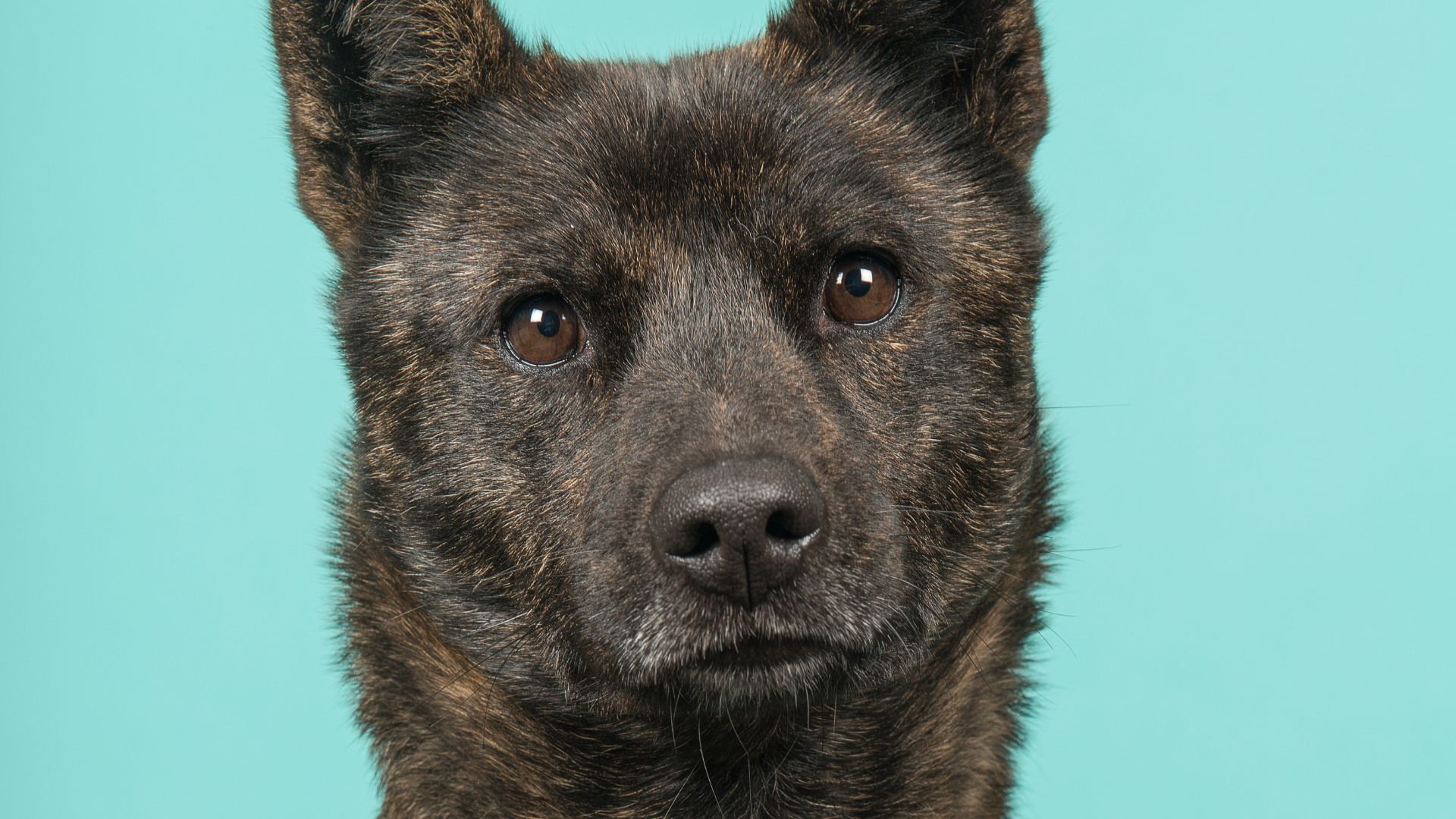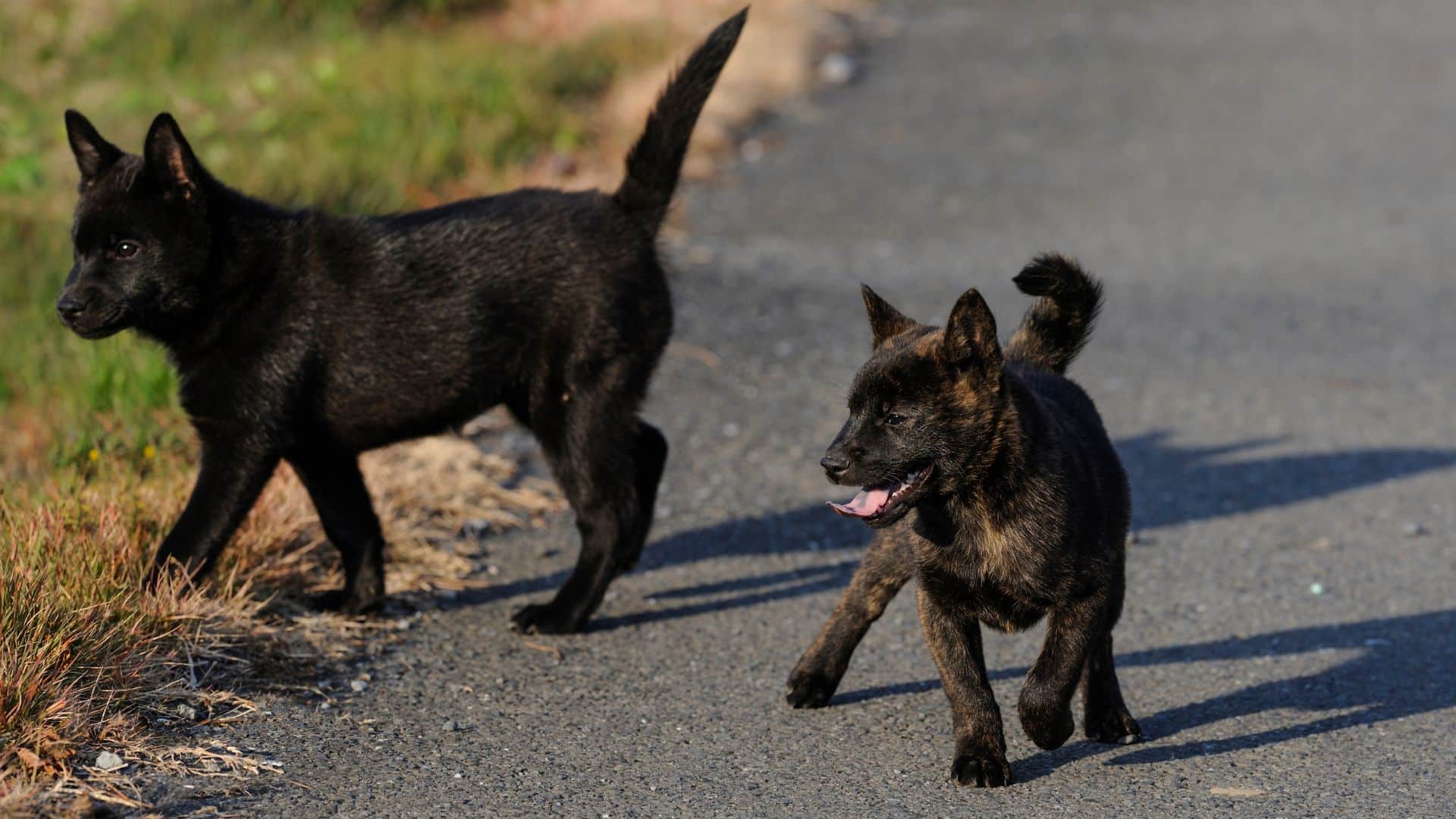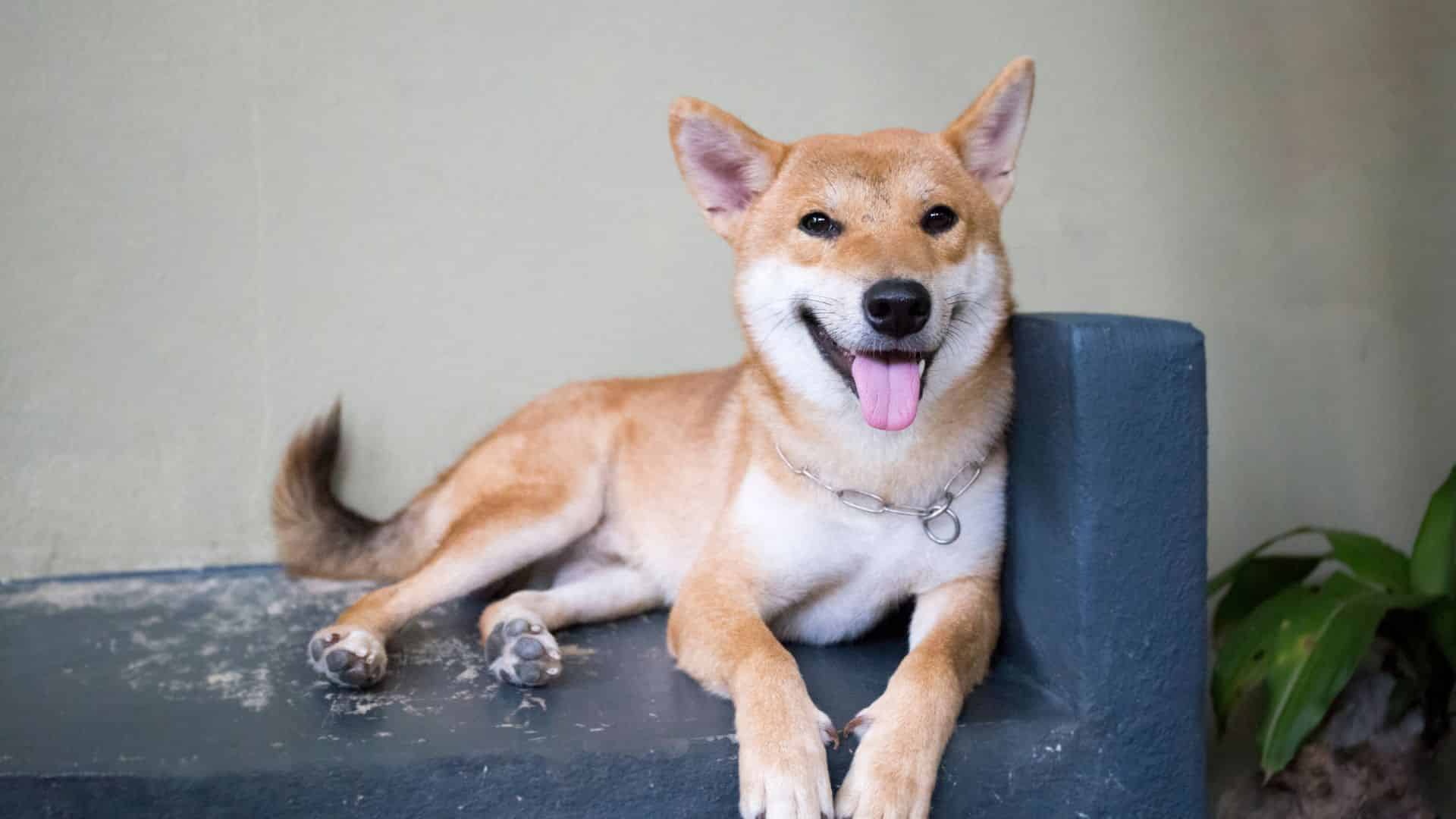Getting to know the Kai Ken dog breed is a challenge, but worth the effort if you can accomplish it. The Kai Ken is a rare Japanese breed that has been around for centuries. Yet it is threatened today. Also known as the Tora Inu (Tiger Dog), it is a national monument in Japan.
Originating in Kai, a mountainous region near Mount Fuji in Japan, it is considered a rare breed even in their native land. Overall, it is a medium-sized dog with a beautiful brindle-like coat that resembles the markings of a tiger.
Its strong and agile physique allows it to excel in various activities such as hunting, tracking, and agility trials. Despite its fierce appearance, the Kai Ken is known for its loyal and affectionate nature towards its family members.
History of the Kai Ken Dog

Being one of just six native Japanese dogs, the history of the Kai Ken Dog is a little mysterious. As opposed to being “bred” they were discovered. Near Mount Fuji in the in the mountains of the Kai Province, the Kai Ken was found in 1929. By 1931 the first, largest and oldest of the Kai Ken Registries was formed.
By 1934, the Japanese Kennel Club recognized the breed. The Kai Ken is a hunting dog adapted to the steep terrain of the mountains of Kai. Plus, they are built to climb and hunt wild boar, Japanese crow, pheasant, deer, and bear. The Government of Japan named the Kai in 1933 as a living natural monument.
No one is sure but the theory is that the Kai came to the United States with military soldiers in the 1950’s. No knows if these dogs have any offspring surviving but in 1990 four dogs came over the US – one male and three female Kai Ken puppies that were imported as breeding stock.
In ’91 there were 6 more and in 1992 there was one. These eleven dogs are the gene pool for all the Kai Ken Dogs bred in the U.S.. The Kai Ken breed registry is managed by the Kai Ken Aigokai.
Moreover, the Kai Ken comes in two varieties the Shika-Inu-gata type and the Shishi-Sugata type. They have tiger-like stripes in a variety of shades. The Shishi is stockier than the Shika and has more of a bear looking face. On the other hand, the Shika is a thinner, longer dog and his face is more foxlike.
Shika
The Shika is more geared to deer hunting than the stockier Shishi. The mountain-dwelling Kai Ken are the ancestors of the current breed and since they were fairly isolated for so many years, they are thought to be the purest of all Japanese breeds. The breed is not recognized by the AKC but they are in the Foundation Stock Service Program. They need 150 registered dogs in order to be recognized.
What Does a Kai Ken Look Like?

Kai ken is a medium-sized dog with the striking tiger strips has pricked ears and a wedged head. They are strong and muscular with the tail held up in a curled position. They come in a variety of shades including brindle, black, red, a mix of these.
It can take up to five years before the brindle striped markings show up. Red is the rarest of the colors. These colors were a great camouflage for the dog’s hunting in the mountainous forests. Similar to the Nihon Ken Hozonkai, the kai ken’s coat is double, harsh and of medium length. They “blow” their undercoat twice a year.
Furthermore, they need their ears cleaned and inspected regularly to prevent infection. The black brindled dogs are called Kuro-Tora, the Chu-Tora is between black and red and the red brindles are called Aka-Tora.
Does the Kai Ken Fit into your Family?
This is a very intelligent breed and they are brave, alert and agile. This makes they both great guard dogs and great hunters. But do they fit into your family? They are incredibly loyal to their people but with strangers, they are reserved and alert. The Kai is good with older kids, loves to swim, and usually likes other dogs.
They are not good with small pets though as they see rabbits, hamsters, rats and guinea pigs as prey. Other Japanese breeds are more independent than the Kai mostly because they want to please their people. They make great companions and guardians.
However, they can be stubborn and reserved. Early socialization is essential. They are only comfortable when they are in your presence. They will be loving and loyal to training. Be consistent.
What to Expect Out of Kai Kens?
A Kai in your home will need mental and physical exercise daily. Remember these are working dogs and they will want a job. They can play inside or out. They are adaptable and can live anywhere if they get the moderate daily exercise that they need.
Being intelligent and quick learners, they love to learn and perform tricks. However, like any bored dog, if they do not get the mental and physical stimulation they need, they can become very destructive. In fact, the breed is in every way a primitive dog. They are not aggressive, but they can be territorial.
They will stand their ground. Be consistent if possible, with when you exercise them. Find out about any health concerns before you buy. They are generally healthy as a breed, but breeders should test for dysplasia of hips and elbows and any patella problems.
How to Raise A Kai ken Puppy?

Kai kens typically have a wedge-shaped head with almond-shaped eyes and erect ears. To raise a Kai ken puppy, it is important to start with proper socialization and obedience training at a young age. Additionally, providing them with regular exercise and mental stimulation will help prevent boredom and destructive behavior.
The dog-friendly breed can climb trees and cross rivers when they are bird-hunting. It is important to provide them with plenty of opportunities for physical activity and mental stimulation, such as daily walks, interactive toys, and puzzle games. This will help keep their intelligent and active minds engaged, preventing them from becoming restless or engaging in destructive behaviors.
Additionally, incorporating positive reinforcement techniques during training sessions will help foster a strong bond between you and your Kai ken puppy, making the training process more enjoyable for both of you.
Other breeds may also benefit from these activities and training techniques, but it is important to tailor them to the specific needs and characteristics of each breed. For example, some breeds may require more intense physical exercise or mental challenges than others.
Consulting with a professional dog trainer or doing research on your specific breed can help ensure that you are providing the best care and training for your furry friend.
Training Kai Ken Dogs: A Rare Breed With Destructive Behavior
These dogs respond well to obedience training and thrive in environments where they have clear boundaries and consistent rules. It is important to provide them with mental stimulation and physical exercise to prevent boredom, as their destructive behavior often stems from lack of stimulation.
Additionally, positive reinforcement techniques such as rewards and praise work best with Kai Ken dogs, as they are highly intelligent and eager to please their owners. Reward based training also works well for Kai Ken dogs because it helps build a strong bond between the dog and its owner.
Consistency is key when training these dogs, as they can become easily confused if rules and expectations are not clear. By providing them with structure and positive reinforcement, owners can help channel their energy into more appropriate behaviors and prevent destructive tendencies.
Kai Ken Care: Caring For The Native Japanese Breeds

Kai ken are known to be hunting dogs and they can cover vast distances in search of prey. These dogs have a strong prey drive and require regular exercise to keep them physically and mentally stimulated. Additionally, due to their history as working dogs, Kai ken are highly intelligent and thrive when given tasks or challenges to solve.
It is known for its hunting prowess and ability to track scents, making it an excellent choice for activities such as scent work or nose work. However, it’s important to note that Kai ken can be independent and stubborn at times, so consistent training and socialization from an early age are crucial to ensure a well-behaved and obedient companion.
They have the protective instincts of a German shepherd, which makes them excellent watchdogs and loyal family companions. Despite their independent nature, Kai ken are known to form strong bonds with their owners and are often very affectionate towards them. With proper training and socialization, they can also get along well with other pets and children, making them a versatile addition to any household.
How is the Kai Ken Diet?
According to the American Kennel Club, the Kai Ken dog diet should consist of high-quality dog food that is appropriate for their age, size, and activity level. It is recommended to feed them a balanced diet that includes protein, carbohydrates, fats, vitamins, and minerals.
Additionally, it is important to consult with a veterinarian to determine the specific dietary needs of your Kai Ken dog and make any necessary adjustments to their diet. With dog ownership comes the responsibility of providing proper nutrition to ensure their overall health and wellbeing.
Training And Exercising
It is considered a hunting dog, so you will need to maintain its physical and mental stimulation through regular exercise and training. This breed is known for its high energy levels, so daily walks, runs, or engaging activities such as agility or potty training are essential to keeping them happy and healthy.
Additionally, providing them with puzzle toys or tasks that challenge their intelligence can help satisfy their natural hunting instincts. These dogs thrive on mental stimulation, so incorporating training sessions into their daily routine is crucial.
Maintenance And Grooming
The Japanese dog requires occasional brushing to keep its coat healthy and free from tangles. Additionally, regular grooming sessions help to distribute natural oils throughout the dog’s fur, promoting a shiny and well-maintained appearance.
Some individual dogs may require more frequent brushing, especially during shedding seasons, to prevent excessive hair buildup and matting. It is also important to regularly check and clean their ears to prevent infections, as Japanese dogs are prone to ear issues due to their floppy ears.
Amazing Health
These animal are known to maintain a healthy weight and have a lower risk of developing chronic diseases. Additionally, they are often more active and have higher energy levels compared to their overweight counterparts.
Some dog breeds, like the Kai Ken, suffer from hip dysplasia, a condition that affects the hip joints and can cause pain and mobility issues. However, with proper care and regular exercise, this condition can be managed effectively, allowing the dog to lead a happy and healthy life.
A few Kai Ken dogs have been diagnosed with PRA (progressive retinal atrophy) via genetic testing, which is a degenerative eye disease that can lead to vision loss and blindness. However, responsible breeders are working to reduce the prevalence of this condition through selective breeding.
What Kind of Coat Do Kai Kens Typically Have?
Kai ken makes is great for apartment living because they have a thick double coat that provides insulation in both cold and hot weather. This coat is known for its brindle coloration, which adds to their unique and beautiful appearance.
Red brindle and black brindle are the two main colors of their coat, with variations in shades and patterns. The coat is also waterproof, making Kai Kens well-suited for outdoor activities and water sports.
Brindle coat
Brindle coats are known to be low-maintenance and require minimal grooming. The dense fur helps to protect them from harsh weather conditions and keeps them warm during colder seasons. Additionally, their coat is resistant to dirt and debris, making it easier to keep clean.
Double coat
Overall, it is considered a double-coated breed, and the Kai Ken’s double coat provides extra insulation and protection. The undercoat is soft and dense, while the outer coat is coarse and straight. This combination helps to regulate their body temperature and keep them comfortable in various climates.
How much does a Kai Ken puppy cost?
If you want a smart, good looking and very rare dog then the Kai Ken tiger dog just might be the one for you. Yes, they are rare and might be hard to find. They might be expensive as well. Certainly, they are not cheap and from a good breeder, they can run anywhere from $1500 to $3000.
If you can afford it and if you have the time and temperament for this rare breed, they are certainly worth the time and the cost. Overall, it is a healthy breed that can live a long and happy life with proper care and attention.
You can expect to pay around this amount for a well-bred puppy from a reputable breeder. The same breed costs significantly less at a rescue or shelter, but it is important to consider the potential additional expenses for medical care and training.
Are Kai Ken aggressive?
According to the Kai Ken breed club, Kai Kens are known for their strong hunting instincts and protective nature. While they can be reserved with strangers, they are generally not aggressive if properly socialized and trained.
Other animals are considered more aggressive than Kai Kens, such as some terrier breeds or certain types of guard dogs. However, it is important to note that individual temperament can vary within any breed, so early socialization and training are crucial for a well-behaved Kai Ken.
Why Should You Get a Kai Ken dog?
AKC Foundation Stock Service said that they are not small dogs, but they are also not too large, making them a suitable choice for individuals or families living in apartments or smaller homes. Additionally, Kai Kens are known for their loyalty and devotion to their owners, making them excellent companions and family pets.
Overall, they are like a little bear that you can take on adventures and cuddle with at the end of the day. With their strong hunting instincts and intelligence, Kai Kens excel in various dog sports and activities, such as agility or leash training.
Their alertness and protective nature also make them great watchdogs, providing a sense of security to their owners. However, the Kai Ken have a lifespan of 14 to 16 years. However, they can be susceptible to Lyme disease, so watch for ticks.
Conclusion
Kai kens are intelligent, agile and athletic dogs can fit into your family with some effort. Never forget they are great hunters and that hunting instinct doesn’t go away even if it is dormant. They need a leader and it needs to be you. If they have that leadership, enough exercise and training they make great family dogs.
Additionally, they are even better if you are agile and athletic and love to participate in outdoor activities. They love to hike but they shouldn’t be off-leash, or they will run off after prey. They excel at agility trials, tracking and field trials.
If you do not have a lot of space in your apartment, you should consider getting other smaller pets, such as cats or small rodents, to keep them company. While they can adapt to apartment living, they still require regular mental and physical stimulation to prevent boredom.
Last Updated on 16/03/2025 by Karen Snow
Hi! I’m Karen and a certified dog lover. As a freelance writer and blogger, I do my best to squeeze in some time with my dogs, learning more about the way they act and how I can make sure that they continue to stay well-cared for by yours truly.
My dogs have helped me through a lot, and this is my way of giving back to them! Besides animals, I also love to travel and cook, having explored my country’s restaurants and unique places. Follow me as I show you all the amazing tips and bits of information I learn along the way about our furry friends!
